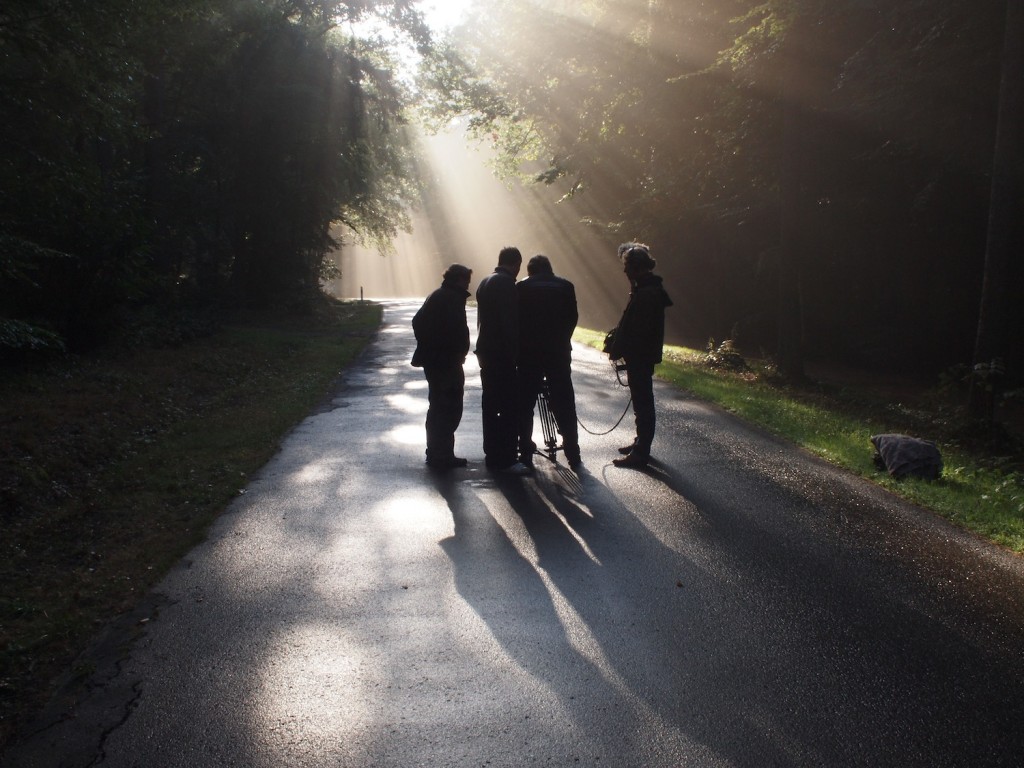On the Riesling Road you find beauty and mystery, or maybe they find you? But it depends on being open for them, on opening the doors of perception as far as you can. Yesterday evening I was in Munich for the much delayed celebration of the completion of the third series of ‘Weinwunder Germany’, Wine Wonder Germany, for Bavarian Public Broadcasting (BR). It was great to see the team – my co-writer and the director Alexander Saran, cameraman Florian Schilling and camera assistant Florian Bschorr (sound man Peter Wuchterl sadly couldn’t make it) – again, also all the people from the production company Megaherz and Prof. Dr. Thomas Gruber who was Director General of BR when the series was commissioned more than three years ago. When the above picture was taken we were on the Riesling Road shooting. We had a tight schedule, but the scenes of me riding through the Taunus forest above Rüdesheim/Rheingau were a case of shooting from the hip and grasping the moment before it was gone. This is stressful, as is the struggle to get a nervous winegrower to open his or her heart in front of the camera, which is one reason why we were so very merry yesterday evening; the third series is in the can and we all feel very happy with the results.
Now I’m on my way by train to Alsace where I will spend the rest of the week catching up on what’s happened there during the last five years. When I first travelled to the only part of France where Riesling is really at home back in 1987 it was a mind-expanding experience. The leading Alsatian winemakers were making dry wines that were far superior to those in Germany and they had a serious grip on terroir. I’ll never forget Leonard Humbrecht of Zind-Humbrecht pouring me his 1983 Riesling Grand Cru Rangen. It changed my whole conception of how Riesling could taste! The spicy-minerally character was of breathtaking intensity, but the wine was beautifully balanced, and the properly dry style of the wine fitted this perfectly. Of course, I wasn’t the only one to taste those wines and Faller (Weinbach), Kreydenweiss, Trimbach and Zind-Humbrecht all had an enormous influence upon the leading German winemakers of that time. Then something went wrong and a lot of the top wines from Alsace simultaneously became more massive, softer and sweeter. Worse still, from the label it was impossible to tell how dry/sweet a particular wine was going to be, and although Robert Parker showered the wines in this new style with high scores many markets rebelled against them.
This afternoon my first appointment is at Zind-Humbrecht just outside Turckheim, where I will meet up with Olivier Humbrecht (Leonard’s son) who built the current winery in 1992 and subsequently converted the estate to biodynamic cultivation. Often those big, supple, sweet Alsace wines were not very successful copies of his always remarkable and sometimes awesome wines. Almost a decade ago they moved in a drier direction which I liked since it made them more food compatible, but they remained extremely concentrated wines that demanded your full attention. Sometimes I wondered if there was a bit too much of the taste of noble rot in them, feeling that this distracted somewhat from the mineral spice (at least when the wines were freshly released). It’s a couple of years since I last tasted a range of current wines from Zind-Humbrecht, so although I’ve known Olivier for more than twenty years I’m not quite sure what to expect. That’s a rare situation for me to be in. That’s the reason it says “Part I” at the top: WATCH THIS SPACE !


![120114_riesling_global_RZ [1600x1200]](http://www.stuartpigott.de/wp-content/uploads/2013/04/120114_riesling_global_RZ-1600x12009.jpg)
I just could not depart your site prior to suggesting that I extremely enjoyed the usual info
a person provide on your guests? Is going to be back often to check up on new posts
whoah this weblog is great i love studying your
articles. Keep up the good work! You understand, lots of individuals are searching round for this information, you could help them greatly.